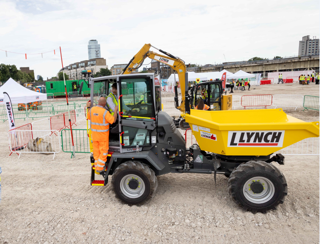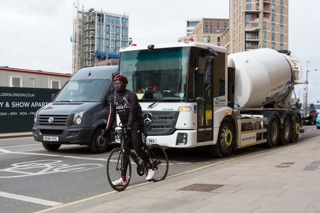Cities across the UK could be about to follow London’s lead and introduce enhanced safety standards for trucks based on the Direct Vision Standard (DVS).
Transport for London (TfL) says it has received a lot of interest in its scheme both in the UK and in mainland Europe, and it is keen to see the safety standard rolled out nationwide.
“Our end goal is not to have a specific regulation for London,” said Alina Tuerk, delivery planning manager for freight at TfL. “We really want this to go wider than London, rather like FORS (Fleet Operator Recognition Scheme).
“It has the potential to become national; it has the potential to become international.”
The DVS, announced in 2016 by Mayor of London Sadiq Khan, was developed to improve the design of heavy goods vehicles (HGVs) involved in collisions with vulnerable road-users, where a contributory factor was the blind spot.
However, Tuerk told delegates at the recent FORS members’ conference that HGVs being disproportionately involved in collisions with cyclists and pedestrians is “not unique” to London.
Both London and Manchester are above the urban average. The capital reports eight casualties per billion cyclist kilometres, while Manchester reports five, compared with a national average of just below four.
More than 140 cyclists were killed or seriously injured on Greater Manchester roads last year. Several collisions involving HGVs have also occurred in the city centre in the past few months, resulting in serious injuries for cyclists involved.
Transport for Greater Manchester (TfGM) told Commercial Fleet it had been following the London initiative and acknowledged the safety benefits it provides for road users.
A spokesman said: “We are exploring a range of HGV- and cycle-related measures to improve road safety on Greater Manchester’s roads. However, we are aware that a successful implementation of this specific measure could be dependent on a number of factors such as additional legislation and funding.”
Bristol, meanwhile, which became Britain’s first ‘cycling city’ in 2008, said it supported the London initiative, but that it was “too soon” to tell if it would follow suit.
The DVS has already gained traction with European law-makers. In May, direct vision for trucks was one of the safety measures included in the European Commission’s review of the General Safety Regulation, which governs European vehicle safety and design regulations.
London ban
Using a star system, the DVS rates HGVs more than 12 tonnes from zero (lowest) to five (highest), based on how much the driver can see directly through their cab windows, as opposed to indirectly through cameras or mirrors.
The Mercedes-Benz Econic low cab gets five stars, for example, while the Volvo FMX, without lower door window, receives a zero-star rating. With the door window it is worthy of a single star.
Zero-rated trucks will be banned from October 26, 2020, with one- and two-star trucks banned from 2024.
TfL, however, has proposed a HGV Safety Permit scheme, so trucks not reaching the required standard can continue operating in Greater London if they have certain safety equipment fitted – a so-called ‘Safe System’ approach.
Trucks reaching the required DVS, will automatically have a permit issued, while those having an insufficient star rating will have to take the so-called ‘Safe System’ approach.
Subject to final consultation, they will include: blind spot elimination and minimisation through cameras, both Class V and VI mirrors, and a sensor system with driver alerts.
They would also be expected to be fitted with audible alerts and safety measures to minimise physical impact, such as side-underrun protection.
Furthermore, TfL says it will recommended that all drivers (including those exempt or not in scope of Driver Certificate of Professional Competence) shall undergo specific training on the safety of vulnerable road users and the use and limitations of supplementary vehicle safety equipment.
When the rules are tightened in 2024, TfL says it will take into account any additional technology or safety equipment not available in 2020.
This will become known as the ‘Progressive Safe System’ and will only include equipment that can be retrofitted to the HGV, is industry recognised and readily available on the market at the time.
TfL previously announced there would be no charge for permits and they would start issuing them next October.
The final consultation will take place early next year, more than likely from January.
It will include how best to provide hauliers with information on qualifying equipment for the proposed Safe System. It will also consider how the DVS permits will be administered.
The preferred option for enforcement is through an automatic number plate recognition (ANPR) system.
Visibly safer
In a previous DVS consultation, 91% said they agreed or strongly agreed that the amount an HGV driver can see directly through the cab’s windows plays a role in collisions with vulnerable road users.
Similarly, 92% either agreed or strongly agreed that the amount a driver can directly see should be improved to reduce HGV road risk (commercialfleet.org, June 15).
New research from Mercedes-Benz Trucks revealed a similar set of results, with four in five motorcyclists and cyclists saying they need to see a driver’s face in order to feel safe on the road.
However, while 90% of respondents were aware that truck drivers have restricted visibility, more than half (58%) admitted to having stopped or passed on the inside of a truck, which then turned left.
TfL commissioned its own research, which revealed that when comparing indirect and direct vision, a driver with indirect vision has a 0.7-second slower reaction time.
Tuerk said that may sound like a “very small number” but at 15mph it translated into an extra stopping distance of almost five metres. “Even at 5mph it’s an extra metre-and-a-half,” she said.
Vision zero
The DVS forms part of a ‘Vision Zero’ action plan launched in July by London’s mayor, TfL and the Metropolitan Police. The aim is to eliminate all deaths and serious injuries from the transport network by 2041.
The plan includes the introduction of lower speed limits on TfL’s road network, improvements to existing dangerous junctions and the Direct Vision Standard.
Alongside the enforced changes to trucks, all new London buses must also include new safety measures, including speed limiters, audible alerts for pedestrians and other road-users, and more blindspot mirrors and reversing cameras from next year.
TfL also recently teamed up with the Metropolitan Police for ‘Operation Vision Zero’, which clocked up 4,758 driving offences in two weeks – more than 800 offences higher than an average two week period in 2016.
TfL told Commercial Fleet that 507 drivers were stopped for mobile phone use, 654 for speeding, 559 caught driving without insurance and 1,394 for mechanical defects.
Officers also dealt with 519 cycling offences such as red light jumping.
Bike smart
Last month’s Road Safety Week (November 19-25), organised by the road safety charity Brake, called for drivers to be ‘Bike Smart’.
New analysis by Brake found that, on average, those on two wheels are 63 times more likely to be killed or seriously injured on British roads, per mile travelled, than car drivers.
Last year, 6,043 motorcyclists, 5,604 cyclists and 1,801 pedestrians were killed or injured per billion road miles they travelled. This compares with 238 car occupants and 61 truck drivers.
In its annual Fleet Survey Report, published last month, three-quarters (74%) of respondents said their organisation has the right policies in place to protect cyclists, motor-cyclists and pedestrians.
Interestingly, nine out of 10 respondents to the fleet survey (92%) said cyclists could do more to protect themselves on the roads.




















Login to comment
Comments
No comments have been made yet.